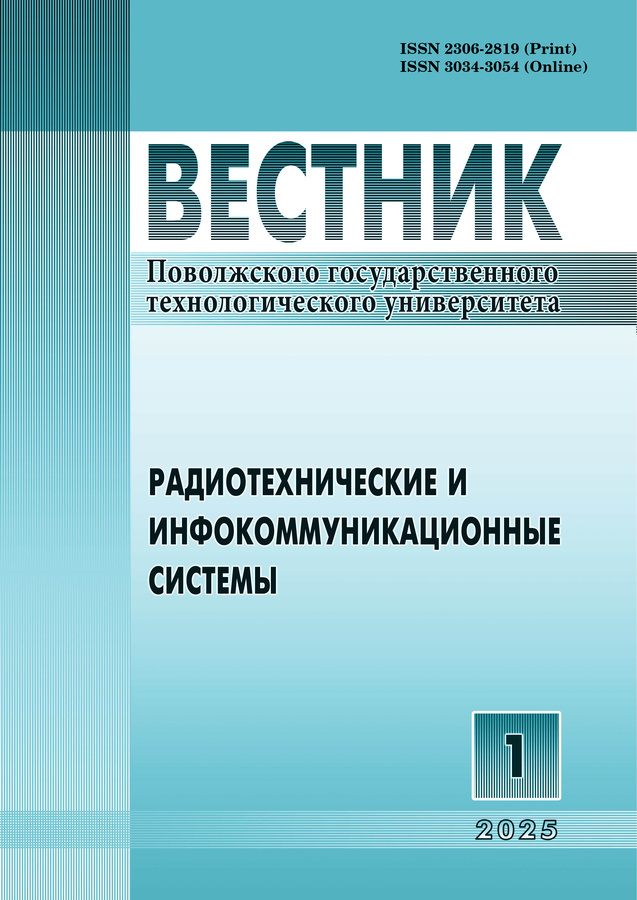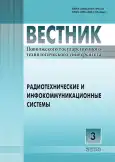Эффективность электронной дофокусировки гибридной зеркальной антенны при контроле профиля рефлектора по сигнальному отпечатку от маяка
- Авторы: Дардымов А.В.1
-
Учреждения:
- Казанский национальный исследовательский технический университет им. А.Н. Туполева-КАИ
- Выпуск: № 3 (2024)
- Страницы: 35-42
- Раздел: ТЕЛЕКОММУНИКАЦИИ И РАДИОТЕХНИКА
- URL: https://journal-vniispk.ru/2306-2819/article/view/276333
- DOI: https://doi.org/10.25686/2306-2819.2024.3.35
- EDN: https://elibrary.ru/BEVTGI
- ID: 276333
Цитировать
Полный текст
Аннотация
Подтверждено улучшение качества покрытия за счёт управления векторами весовых коэффициентов кластеров антенной решётки при контроле текущего профиля рефлектора путём реконструкции параболоида наилучшего соответствия (ПНС) по сигнальному отпечатку наземного маяка. Показано, что алгоритм реконструкции ПНС работоспособен при произвольном положении маяка в пределах рабочей области. Выявлено, что стабильность алгоритма улучшается и точность повышается на 0,1 дБ при расположении маяка у оптической оси антенны. Установлено, что качественная работа алгоритма ПНС обеспечивается, если соотношение сигнал/шум в каналах связи превышает 10 дБ.
Полный текст
Об авторах
Анатолий Викторович Дардымов
Казанский национальный исследовательский технический университет им. А.Н. Туполева-КАИ
Автор, ответственный за переписку.
Email: anatoly.dardymov@yandex.ru
SPIN-код: 5697-1450
аспирант кафедры радиоэлектронных и телекоммуникационных систем Института радиоэлектроники, фотоники и цифровых технологий. Область научных интересов – антенная техника. Автор шести научных публикаций.
Россия, 420111, Казань, ул. Карла Маркса, 10Список литературы
- Temperature distribution and influence mechanism on large reflector antennas under solar radiation: solar thermal effect on reflector antenna / C. S. Wang, S. Yuan, X. Liu et al. // Radio science. 2017. Vol. 52. No 10. Pp. 1253–1260.
- Шендалёв Д.О. Проектирование формообразующей структуры зонтичного рефлектора // Вестник СибГАУ. 2013. № 6 (52). С. 164–173.
- Тайгин В.Б., Лопатин А.В. Метод обеспечения высокой точности формы рефлекторов зеркальных антенн космических аппаратов // Космические аппараты и технологии. 2019. Т. 3. № 4. С. 200–208. doi: 10.26732/2618-7957-2019-4-200-208
- Гряник М.В., Ломан В.И. Развертываемые зеркальные антенны зонтичного типа. М.: Радио и связь, 1987. 72 с.
- Subrahmanyan R. Photogrammetric measurement of the gravity deformation in a Cassegrain antenna // IEEE Transactions on Antennas and Propagation. 2005. Vol. 53. No 8. Pp. 2590–2596.
- Калабегашвили Г. И., Бикеев Е. В., Матыленко М. Г. Выбор устройства для орбитальной юстировки рефлектора крупногабаритной трансформируемой антенны // Решетневские чтения. 2018. Т. 1. С. 121-122.
- Способ компенсации деформаций конструкции крупногабаритной антенны космического аппарата / Е.В. Бикеев, Е.Н. Якимов, М.Г. Матыленко и др. // Вестник СибГАУ. 2016. Т. 17, № 3. С. 673–683.
- Следящий оптоэлектронный мониторинг деформаций в задаче динамической юстировки устройств пространственного наблюдения / Под ред. А.В. Ушакова. СПб.: СПб ГУ ИТМО, 2008. 212 с.
- Dai M., Newman T.S., Cao C. Least-squares-based fitting of paraboloids // Pattern recognition. 2007. Vol. 40. No 2. Pp. 504–515.
- Голдобин Н.Н. Методика оценки формы радиоотражающей поверхности крупногабаритного трансформируемого рефлектора космического аппарата // Вестник СибГАУ. 2013. № 1 (47). С. 106–111.
- Голдобин Н.Н. Анализ эффективности орбитальной юстировки крупногабаритного рефлектора // Решетневские чтения. 2018. T. 1. С. 97–99.
- Голдобин Н.Н. Оценка точности наведения рефлектора на основании информации об отклонениях концов его силовых спиц // Решетневские чтения. 2016. Т. 1. С. 102–104.
- Дофокусировка многолучевой гибридно-зеркальной антенны в условиях эксплуатационных нагрузок / А.Г. Романов, И.Ю. Данилов, Ю.И. Чони и др. // Наукоемкие технологии. 2017. № 12. С. 85-90.
- Nesterov Yu. Introductory Lectures on Convex Optimization: A Basic Course. Switzerland: Springer, 2018. Vol. 137, 604 p. doi: https://doi.org/10.1007/978-3-319-91578-4
- Мочалов В.В. Аттестация алгоритма акустического приближения // Успехи современной радиоэлектроники. 2019. № 12. С. 124–128.
Дополнительные файлы












